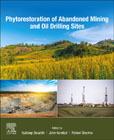
Phytorestoration of Abandoned Mining and Oil Drilling Sites
Bauddh, Kuldeep
Korstad, John
Sharma, Pallavi
Phytorestoration of Abandoned Mining and Oil Drilling Sites presents case studies and latest research for the most effective methods to address the large amounts of waste materials released due to mining and oil drilling activities. In particular, phytoremediation is described as a novel eco-friendly and cost effective method for extraction of toxic compounds by plants for restoration of mining and oil drilling contaminated sites. Plantings on these contaminated areas leads to removal of toxic substances such as heavy metals and hydrocarbons, improvement in the physicochemical and biological properties of the soil, long term forest ecosystem rehabilitation, restoration of ecosystem productivity, stability and biological diversity, and reduction of carbon dioxide. Utilizing worldwide examples, Phytorestoration of Abandoned Mining and Oil Drilling Sites discusses the potential of phytoremediation as an ideal solution for sites contaminated by mining and oil drilling sites. Includes exploration of efficient plants for restoration of contaminated former mining and oil drilling sitesAddresses adverse impacts of toxicants released from mining activities on living organisms, including human healthPresents characteristics of contaminated former mining and oil drilling sites INDICE: 1. Characteristics of Former Mining and Oil Drilling Sites and Adverse Impacts of These Activities on the Environment and Human Health2. An Overview of Phytorestoration of Former Mining and Oil Drilling Sites3. Contamination of the Stream Water and Sediments with Uranium Mine and Their Possible Phytoremediation4. Influence of Open Cast Mining on the Soil Properties of Ledo Colliery of Tinsukia District of Assam, India5. Potential of Purun tikus to Restore the Iron (Fe) Contaminated Acide Mine Drainage by Using Constructed Wetland6. Phytoreclamation of Abandoned Acid Mine Drainage Site after Treatment with Fly Ash7. Role of Fungi in Restoration of Mine Dump Soil Contaminated with Petroleum Hydrocarbons8. Assessment of Native Plant Species Growing in Mining-Spoiled Soils for Phytorestoration of Heavy Metals9. Assessment of Phytoremediation Potential of Plant Species in Copper Mine Tailings10. Phytostabilization of Metalliferous Mine Waste11. Restoration of Coal Mine Waste Sites by Using Plant Species12. Phytoaccumulation of Trace Elements by Grevillea pteridifolia Knight Grown on Iron Ore Tailings13. Evaluation of Natural Phytoremediation Processes Occurring at Ex-Tin Mining Catchment14. Uranium Mine Tailing Remediation by Amending Land Soil and Invading Native Plant Species15. Physiological and Antioxidant Responses in Plants Exposed to Heavy Metals During Cultivation in Mining Dump Sites16. Potential of Ricinus communis for the Removal of Toxic Metals from Mining Dumping Sites17. Phytorestoration Potential of Invasive Plant Species during Cultivation in Mining Dump Sites18. Phytoextraction of Heavy Metals by Tree Species Growing on Hazardous Mining Sludge19. Selection of Plant Species for Phytoremediation of Oil Drilling Sites: An Overview20. Phytoremediation Study of Oil Spill Site Using Common Nigerian Vegetables21. Case Studies of Phytorestoration of Abandoned Oil Drilling Sites22. Phytoremediation of Oil Contaminated Aquatic Sites using Aquatic Macrophytes23. Phytomining: A Sustainable Approach for Recovery and Extraction of Valuable Metals24. Phytomining Potential of Albizia julibrissin Plant25. Restoring Indigenous Knowledge for Mining Dump Sites: A Study at Iron Mining Areas in Jharkhand
- ISBN: 978-0-12-821200-4
- Editorial: Elsevier
- Encuadernacion: Rústica
- Páginas: 800
- Fecha Publicación: 01/11/2020
- Nº Volúmenes: 1
- Idioma: Inglés
